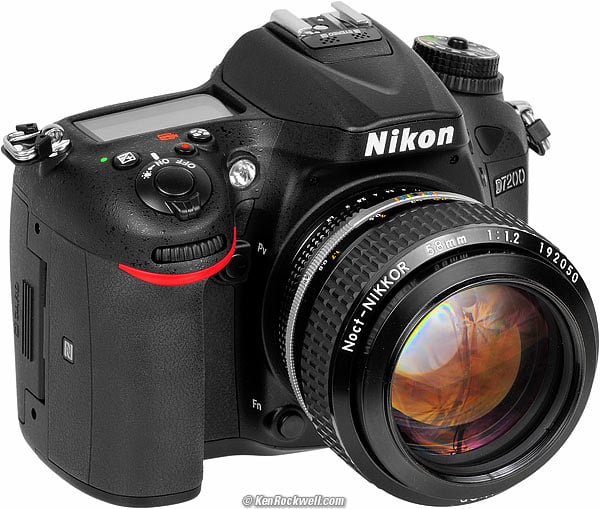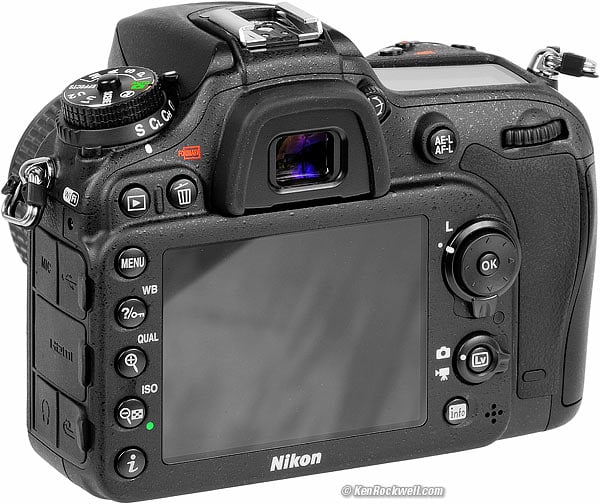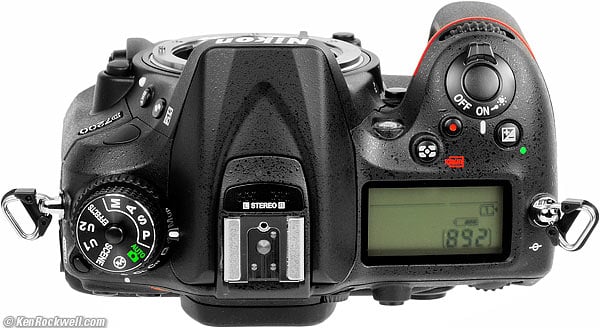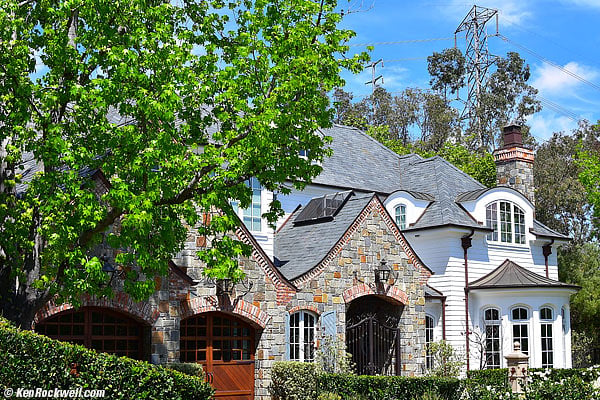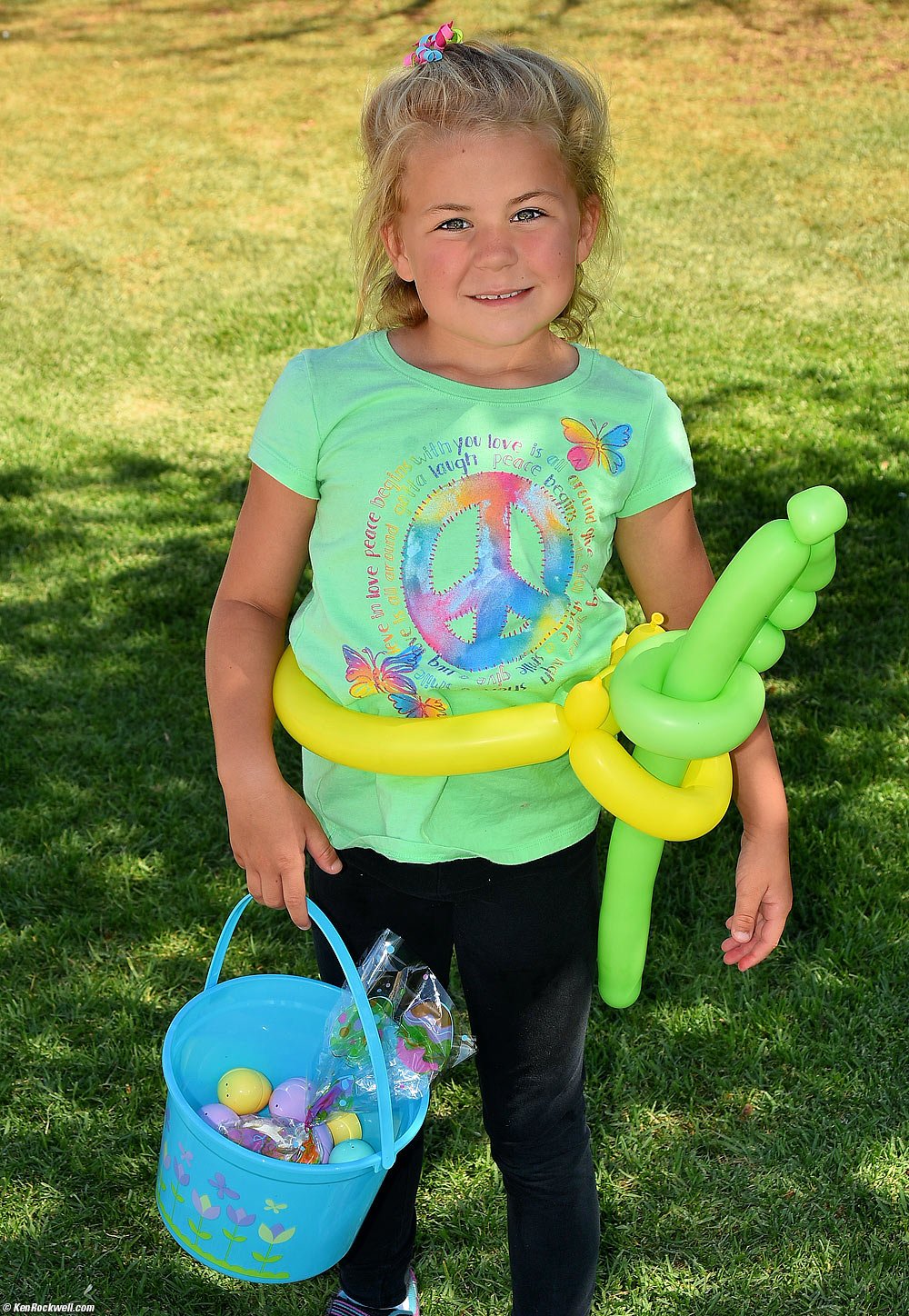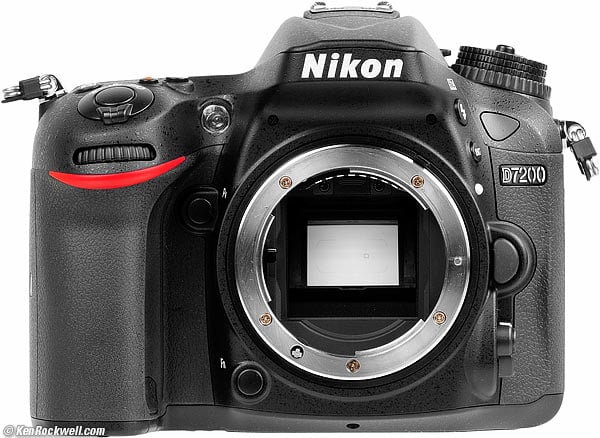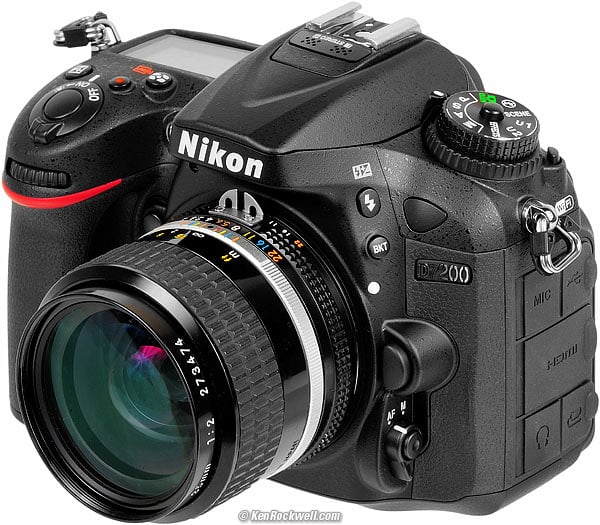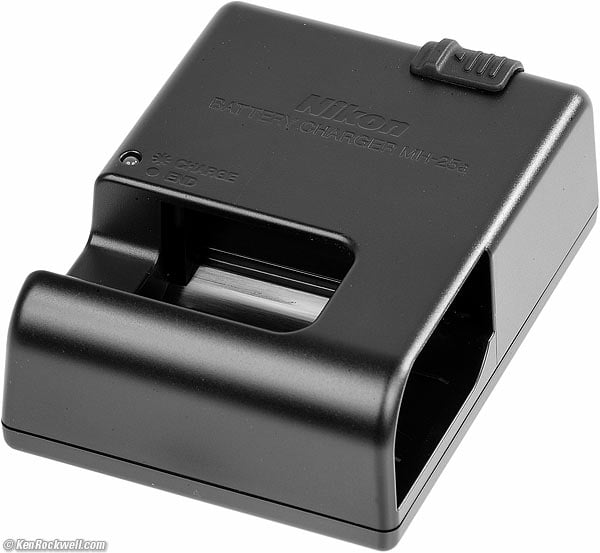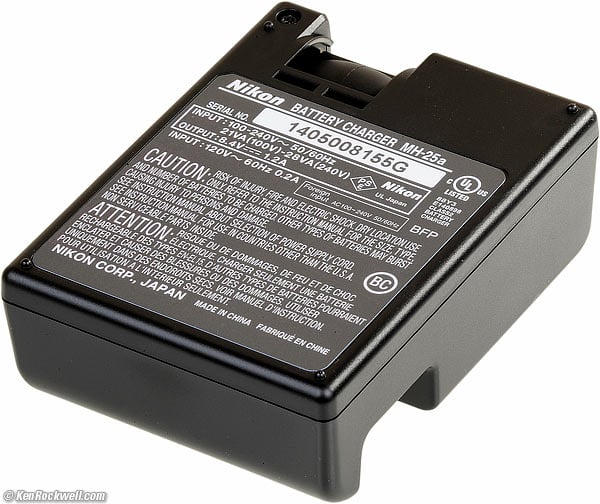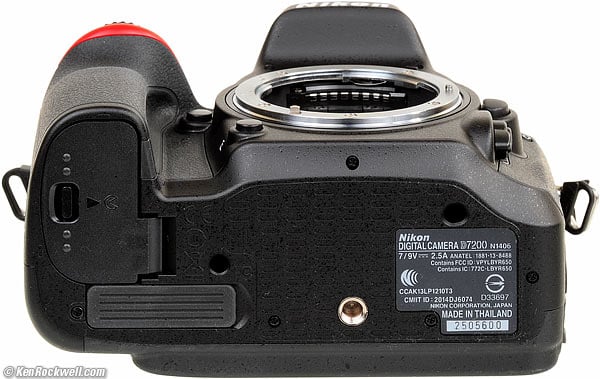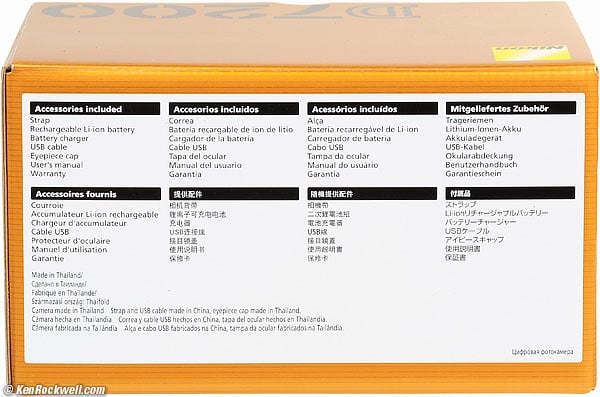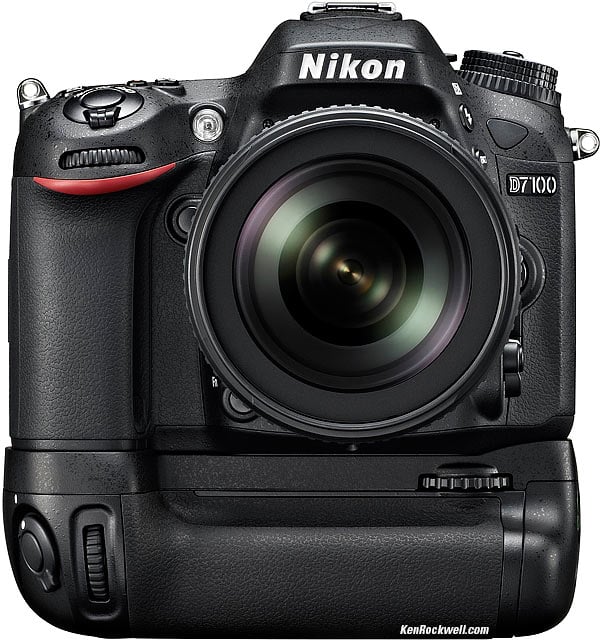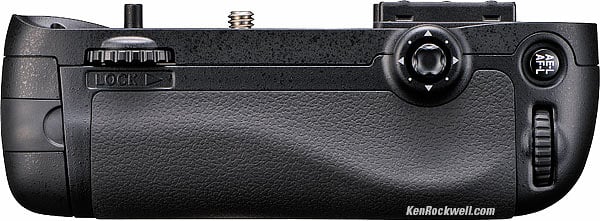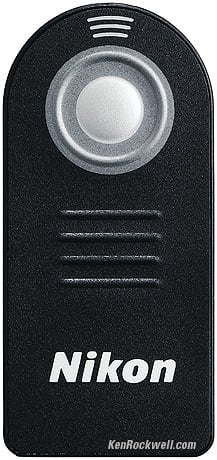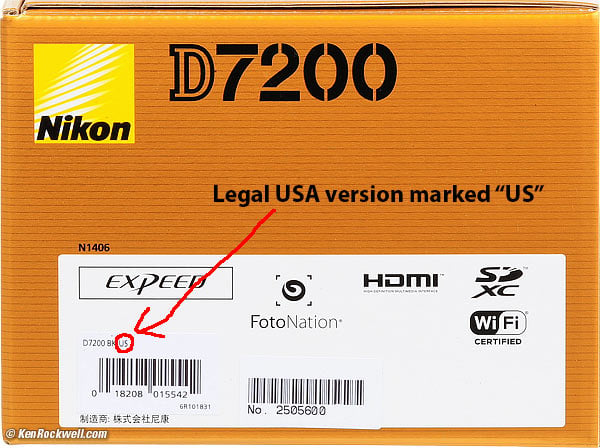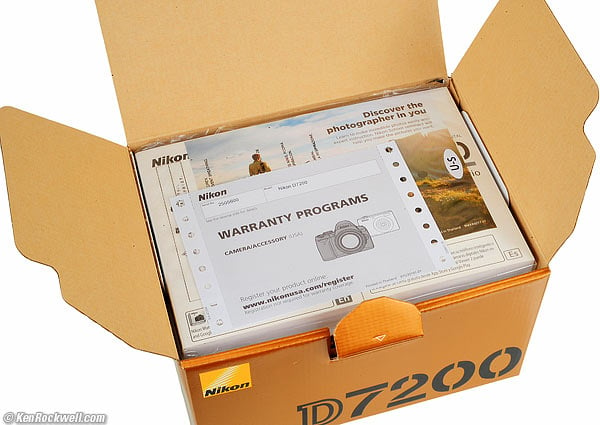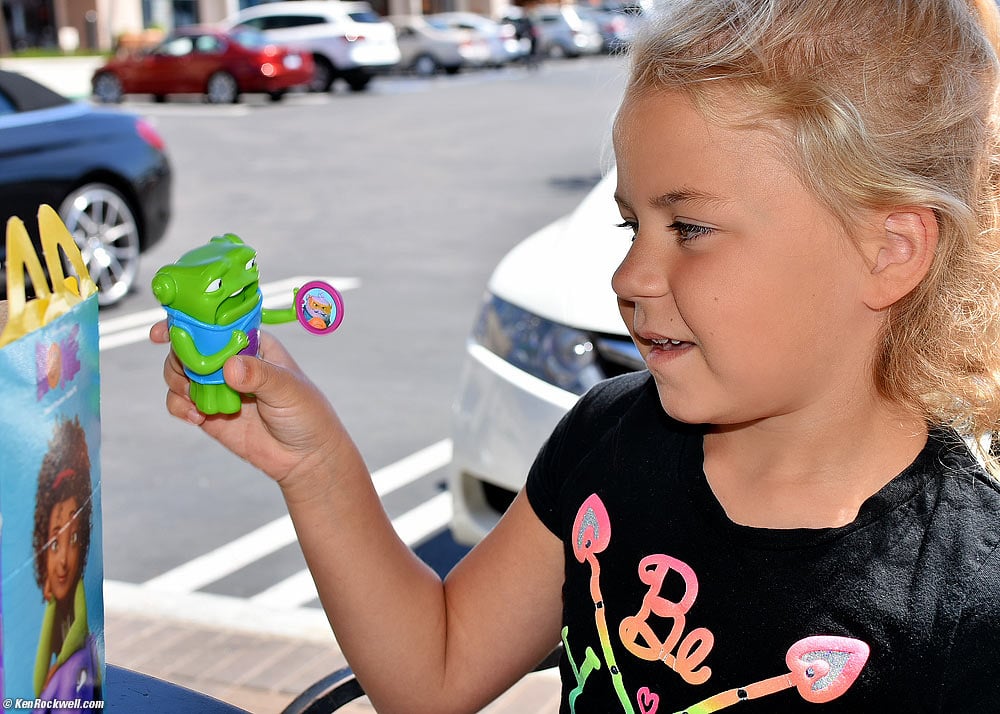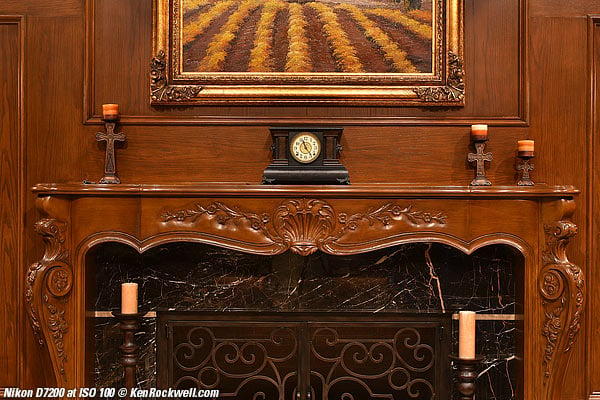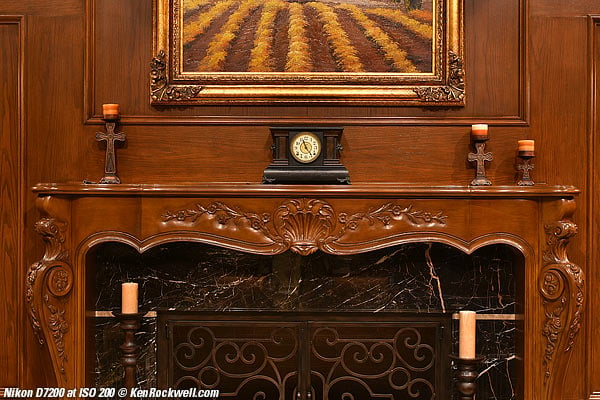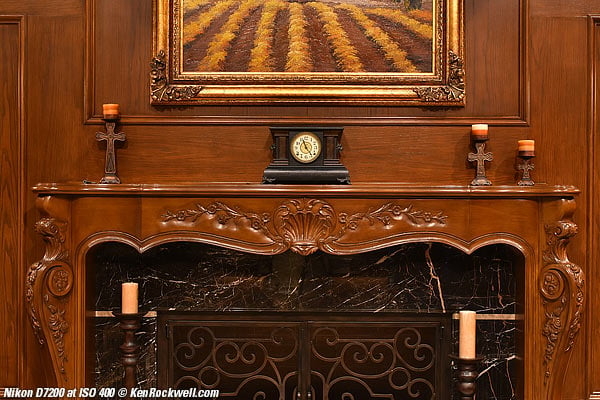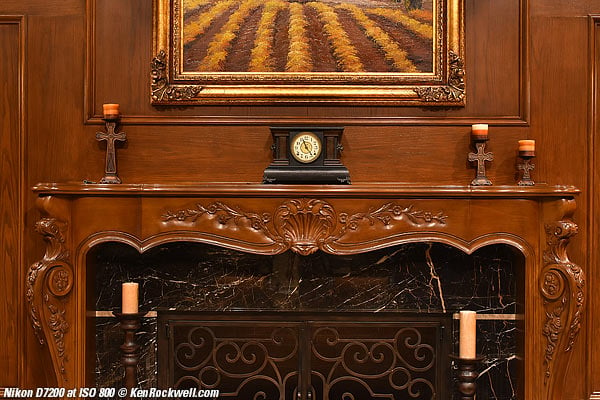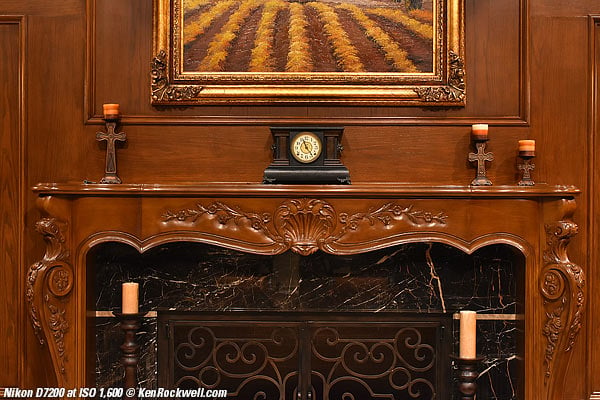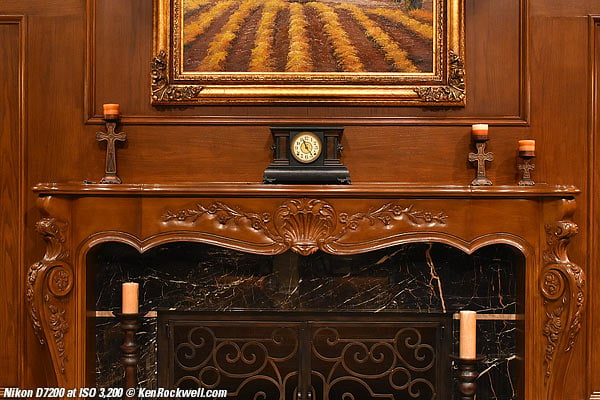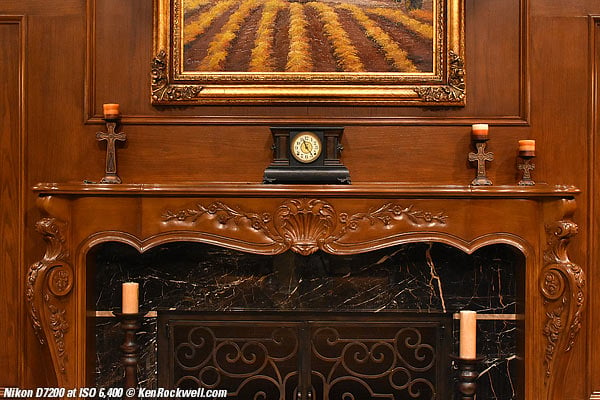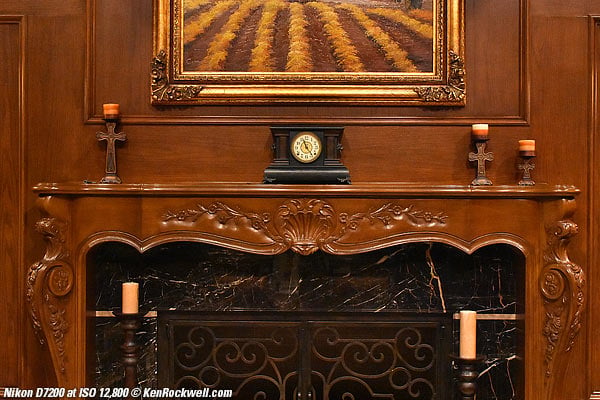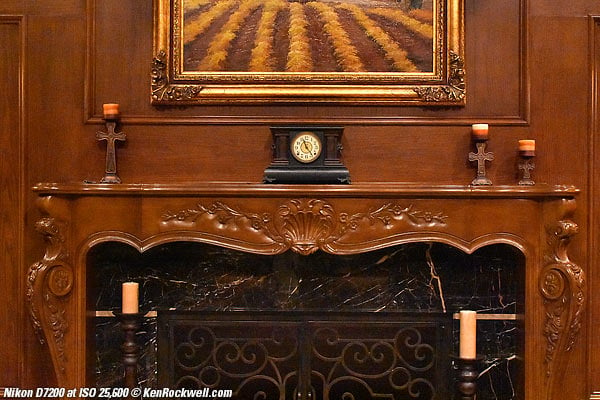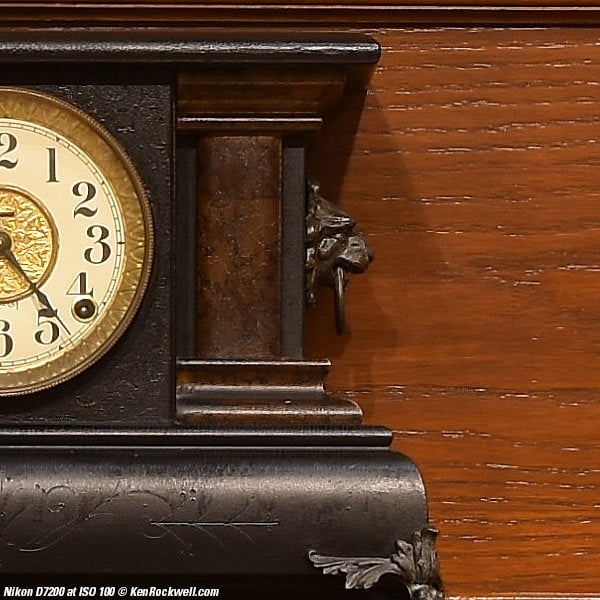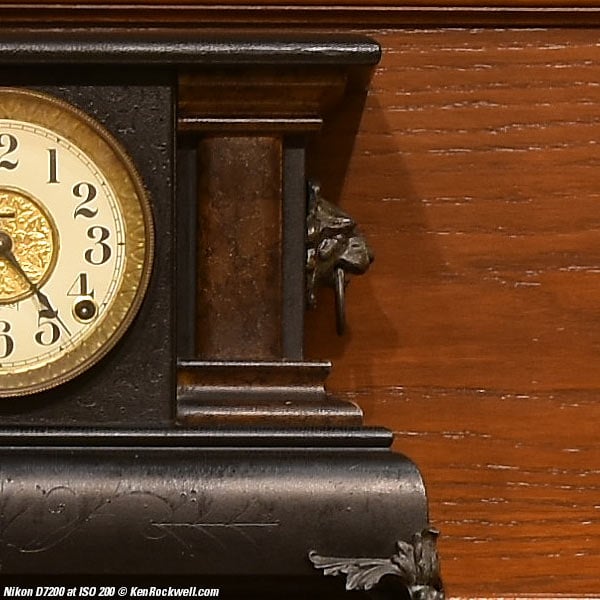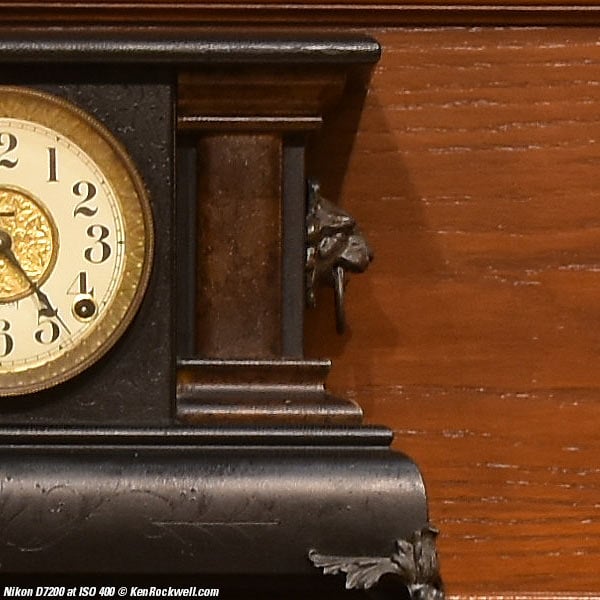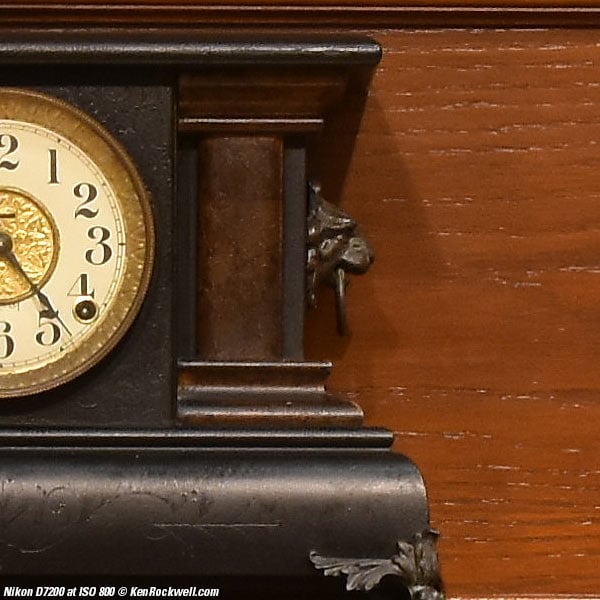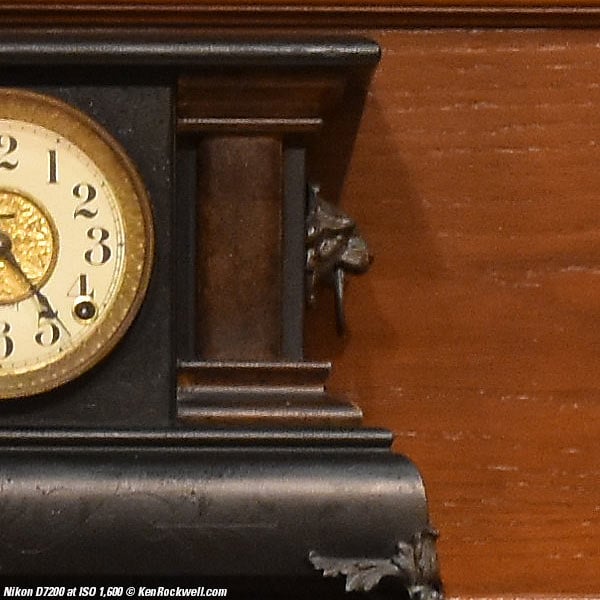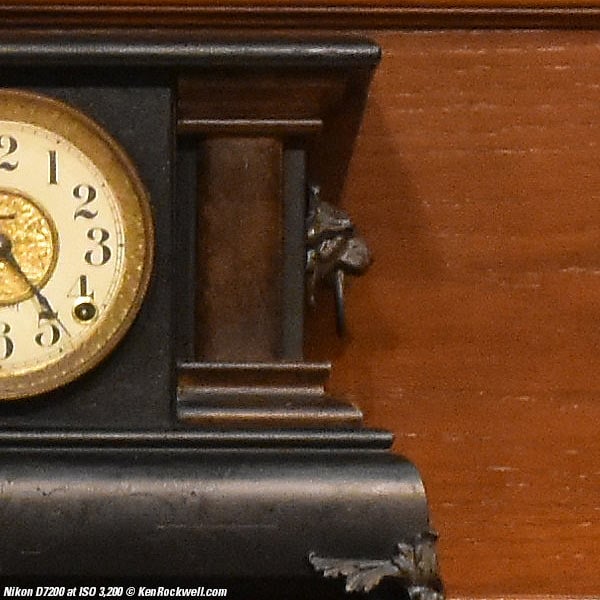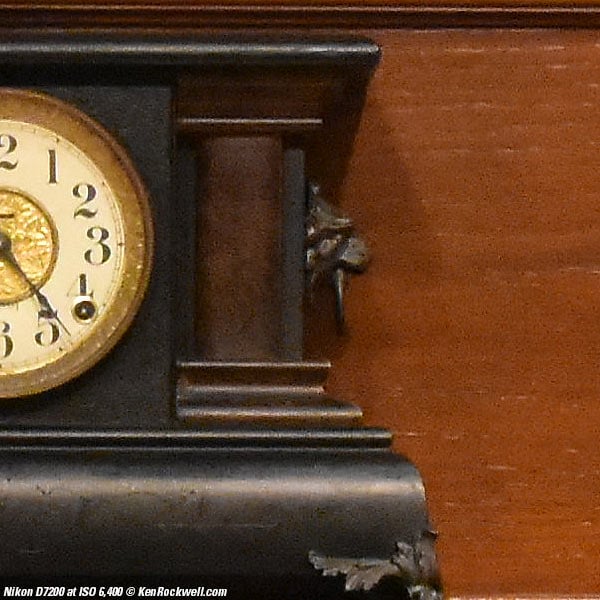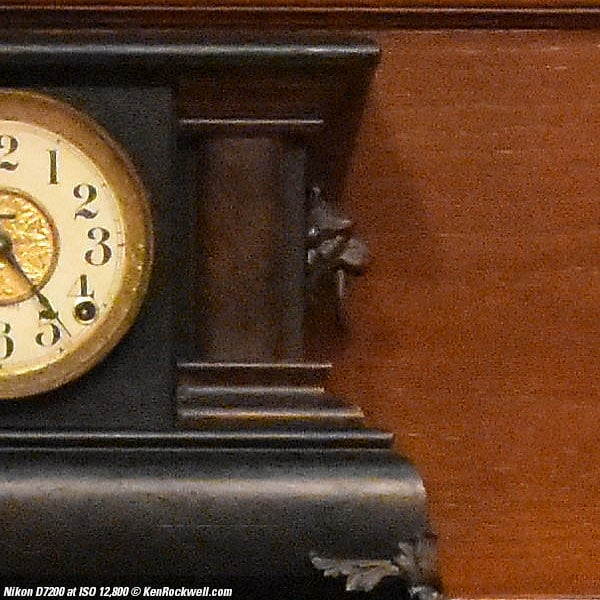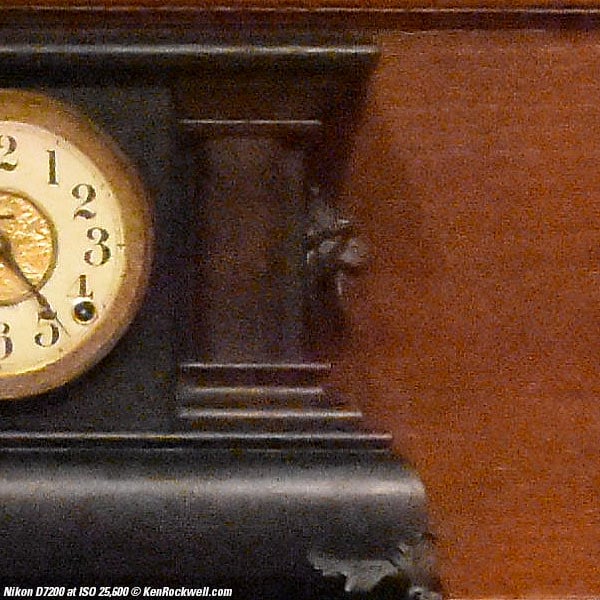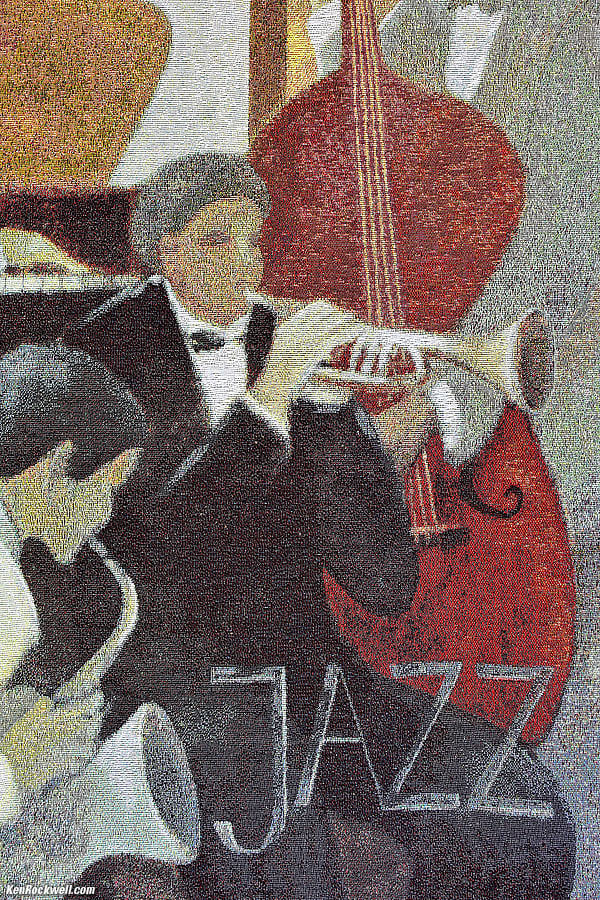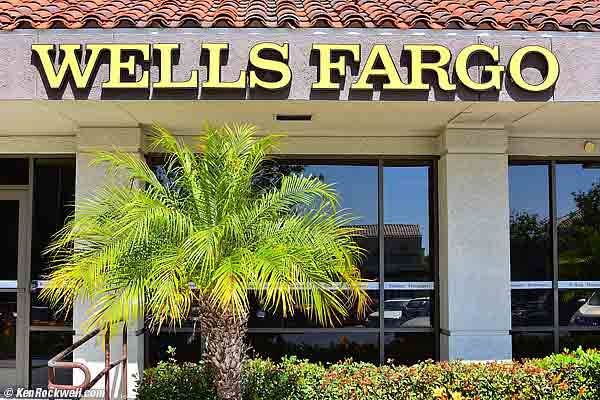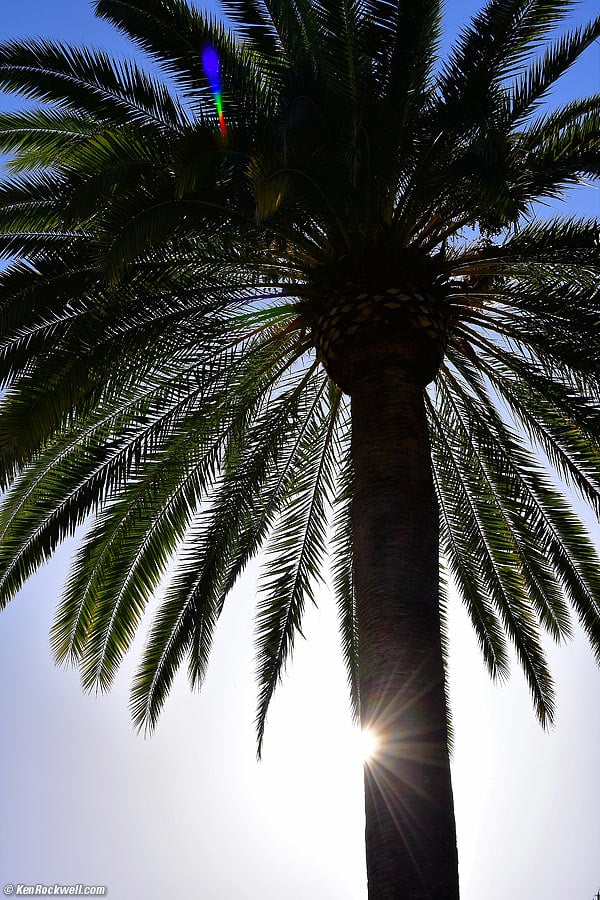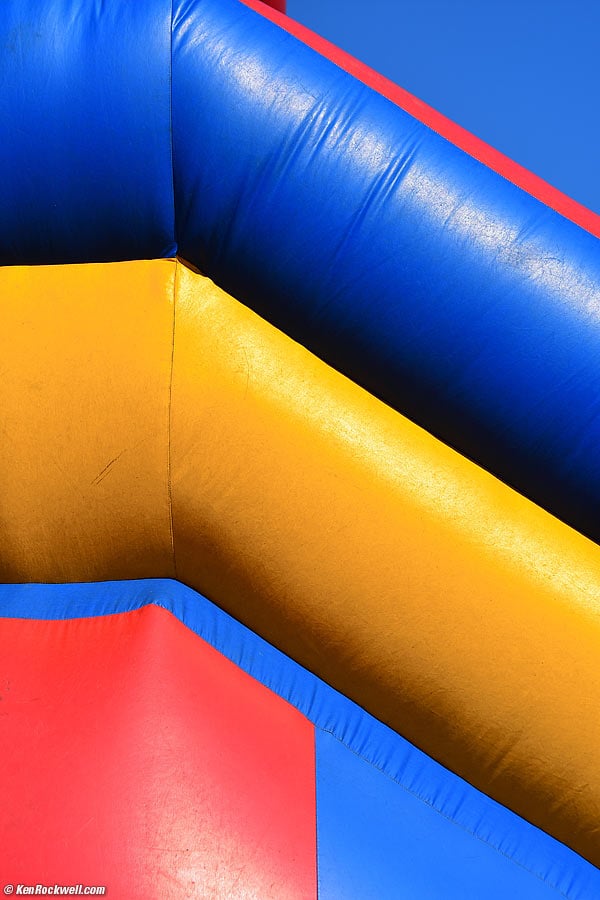Home Donate New Search Gallery Reviews How-To Books Links Workshops About Contact
Nikon D7200
24 MP DX, 6 FPS, NFC Wi-Fi
Sample Images Intro Specifications Accessories USA Version
Performance Compared Usage Recommendations More
Nikon D7200 (27.0 oz./765g with battery and card, about $997) and 58mm f/1.2 Noct-NIKKOR. enlarge. I got mine at Adorama, who has the body for $997, and the kit with 18-140 for $1,297. B&H also has the body and the kit with 18-140mm. I'd also get it at Amazon or at Crutchfield.
This all-content, junk-free website's biggest source of support is when you use those or any of these links to approved sources when you get anything, regardless of the country in which you live. Nikon does not seal its boxes, so never buy at retail or any other source not on my personally approved list since you'll have no way of knowing if you're missing accessories, getting a defective, damaged, returned, store demo or used lens. (My approved sources ship from automated warehouses where no salespeople or lookie-loos can get their greasy fingers on your new camera.) Buy only from the approved sources I use myself for the best prices, service, return policies and selection. Thanks for helping me help you! Ken.
April 2017 Nikon Reviews Nikon Lenses All Reviews
NEW: Nikon D7500.
Back, Nikon D7200. enlarge.
Top, Nikon D7200. enlarge.
Sample Image Files (more throughout the review) top
Sample Images Intro Specifications Accessories USA Version
Performance Compared Usage Recommendations More
Fine home in Corte Madera, 04 April 2015. D7200, 35/1.8 DX, f/8 at 1/250 at ISO 100, as shot. © camera-original file.
Katie and some more of her Easter loot, 05 April 2015. Nikon D7200, Nikon SB-400 flash, Nikon 35-105 AF-D at 42mm, f/7.1 at 1/200 at Auto ISO 100, Perfectly Clear V2. Bigger or Full-Resolution.
Introduction top
Sample Images Intro Specifications Accessories USA Version
Performance Compared Usage Recommendations More
|
|
The Nikon D7200 is Nikon's best DX camera, replacing the old D7100, which replaced the older D7000 from 2010.
Honestly, all of these three cameras are pretty much the same and all are fantastic, and the older models sell for less: the D7000 sells new for less than $600 and the only real difference is that the viewfinder digits are green, not white.
The D7200 has no anti-alias filter sensor, like the D7100 for added sharpness.
What's New top
The D7200 is pretty much the same as 2013's D7100, which is a spectacular camera.
Nikon claims a bigger buffer, but only if you shoot NEF or LARGE JPG. Both the D7100 and D7200 have 100-shot buffers for JPG BASIC or NORMAL shots, but for NEF, the D7200 can buffer about four times as many shots as the D7100. For LARGE JPG, the D7200 has a 100 frame buffer versus the 33 frames of the D7100.
New is NFC Wi-Fi, but it only connects to your phone via an app.
There's a new picture control option of Flat.
There are now time-lapse movies.
All the ISOs look great, so they are no longer locked out as Hi+1 etc. Now we just set the highest ISOs as any other ISO.
The HDMI jack is now full-sized, same as those on Apple TVs, cable boxes and DVD players.
The top LCD is now big, legible and simplified, instead of trying to cram too much information into a small space as the D7100 did. It has a green LED backlight.
Missing top
No GPS. An external GPS-1A ($250) plugs into the remote socket.
Auto LCD brightness control has been removed.
Lens Compatibility top
Front, Nikon D7200. enlarge.
There is a focus motor in the D7200, so it works with every AF lens made since 1986.
Even better, there's an aperture-ring feeler, so it meters with all AI and newer (1977-on) manual-focus lenses. The D7200 also gives full-color Matrix metering and EXIF data with manual-focus lenses if you share the lens' data in a menu. More at Nikon Lens Compatibility.
Manual focus lenses work extraordinarily well, with extraordinarily precise and accurate manual focus, especially for ultra-fast lenses like the 58mm f/1.2 Noct-NIKKOR which tax other camera's more simple focusing systems.
You're always on your own with off-brand lenses like Sigma. Potential incompatibility with future cameras is one of the steep prices one pays for trying to save a few dollars yesterday on a cheap lens. Nikon shares nothing with its competitors about lens compatibility, so if you want to buy a Tamron or Sigma, you're gambling that it will work with tomorrow's camera. Good luck; it's always better to buy used Nikon than new junk-brand lenses if money matters.
Nikon D7200 and 35mm f/2 AI-s: fully compatible. bigger.
Specifications top
Sample Images Intro Specifications Accessories USA Version
Performance Compared Usage Recommendations More
Sensor and Image top
24 MP CMOS DX (23.5 x 15.6 mm) image sensor.
6,000 x 4,000 pixels native.
NO ANTI-ALIAS FILTER.
Also 4,494 x 3,000 [M] and 2,992 x 2,000 [S] settings.
Sensor cleaner.
14-bit ADC.
1.3x crop mode
The crazy 1.3x crop mode uses only the central 18 x 12mm of the sensor for 4,800 x 3,200 pixel images. It also also has lower resolution [M] and [S] settings. While rolling video in this crop mode, you can save 16:9 stills from this crop.
ISO
Auto, 100-25,600 in half or third stops.
White Balance
Two types of Auto White Balance!
Also Incandescent, Fluorescent (7 types), Direct Sunlight, Flash, Cloudy, Shade,
preset manual (up to 5 values can be stored, yay!), Kelvin (2,500 K to 10,000
K).
All offer fine tuning.
White balance bracketing: 2 to 3 frames in steps of 1, 2 or 3.
In live view only, a new "spot" white balance mode.
Picture Controls
Standard, Neutral, Vivid, Monochrome, Portrait, Landscape, Flat; selected Picture Control can be modified.
Adaptive Dynamic-Range Control
Yes, ADR is as expected in Gen 2.
Sets as Auto, Extra High, High, Normal, Low or OFF.
Frame Rates top
6 frames per second.
Buffer top
100 frames, JPG.
8 or 9 frames, compressed NEF at 14 or 12 bits.
6 or 7 frames, lossless compressed NEF at 14 or 12 bits.
Picture File Formats top
JPG, with the usual three levels of compression and your choice of constant size (quality varies with subject complexity) or constant quality (files size varies with subject complexity).
NEF (raw), lossless compressed or efficiently compressed, 12- or 14- bits.
JPG + NEF.
Video top
Stereo mic, built-in.
1,920 x 1,080 at 29.97p, 25p and 23.976p. (59.94p and 50p also, but only with cropped 12 x 18mm sensor).
1,280 x 720 at 50p or 59.94p.
Maximum Recording Time: 30 minutes, or 20 minutes at highest quality setting.
.MOV files holding H.264/MPEG-4 data.
Audio
S-t-e-r-e-O microphone.
Stereo input jack for external microphones (3.5mm).
Linear PCM.
In-Camera Editing
Can clip from the beginning or end of a movie.
AF: 51 Point Field

51 points, same as D7100.
Multi-CAM 3500DX II AF module, slightly newer than the Multi-CAM 3500DX of the D7100.
Only the 15 central sensors can see horizontal lines ('cross type'), the rest only see vertical lines, just like the single focus sensor of the Nikon SP of 1956.
Only the center sensor can work with lenses as slow as f/8.
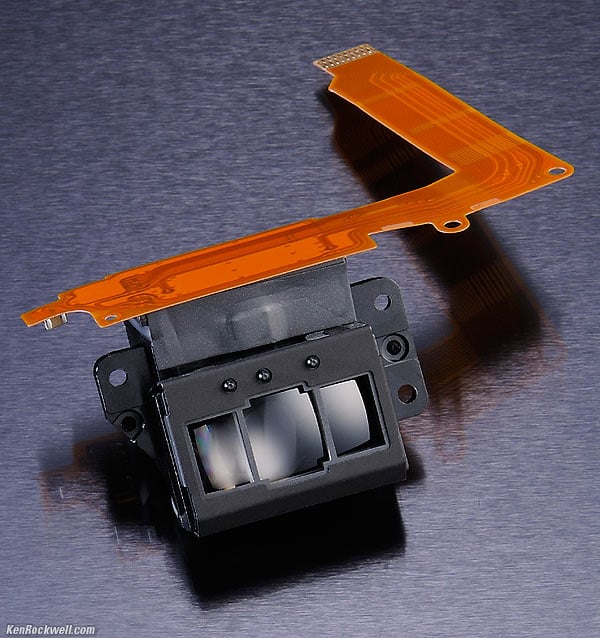
Multi-CAM 3500DX II AF Module.
Dynamic or single point AF.
Configurable in combinations of 9, 21 or 51.
3D tracking, which continuously follows moving subjects within the 51 AF points, highlighting the activated AF point in the viewfinder.
Fine-tuning, for the occasional oddball lens.
AF Illuminator.
AF motor in body for use with all AF lenses, as well as AF-I and AF-S.
Finder top

D7200's glass pentaprism.
Glass pentaprism.
100% coverage
0.53x magnification with standard 28mm (for DX) lens. (0.94x with 50mm lens, which is a telephoto on a DX camera.)
19.5mm eyepoint.
-2 to +1 diopters (D7000 is -3 to +1 diopters).
Trade name of screen: "Type B BriteView Clear Matte Mark II," same as D7100.
Meter top
2,016 pixel RGB 3D Matrix Metering System, center-weighted or spot.
Variable-size center-weighted circle.
Bracketing: 3 to 9 frames at 1/3 or 1/2 stop steps.
Flash top
Maximum speed with flash (sync speed)
1/250.
Trick FP high-speed sync mode.
Built-in Flash
The built-in flash can be used as a remote commander to control Nikon's better external flashes.
Covers a 16mm DX lens.
GN 12 meters (39 feet).
Hot Shoe
i-TTL system for use with SB-910, SB-900, SB-800, SB-700, SB-600, SB-500, SB-300 or SB-400.
PC (Prontor-Compur) Sync Terminal (for studio strobes)
No, but Nikon will sell you a Sync Terminal Adapter AS-15 to add it.
Heck, I use an old Nikon SB-30 flash on my cameras as a remote trigger for my studio strobes instead of a PC cord.
Shutter top
Nikon D7200 Shutter Assembly. enlarge.
Maximum speed with flash (sync speed): 1/250.
1/8,000 to 30 seconds, and Bulb. (30 minutes maximum in Time)
Time, if you buy the excellent $20 ML-L3 infra-red remote.
Single, Continuous High and Low and Quiet advance modes.
"Tested 150,000 cycles"
Self-timer
2, 5, 10 or 20 seconds.
1 to 9 exposures each time, delayed by 1/2, 1, 2 or 3 seconds each.
LCD top
3.2"
3:4 aspect ratio.
1,228,800 dots.
No Auto brightness control as in the D7100, which never worked anyway.
Data Storage top
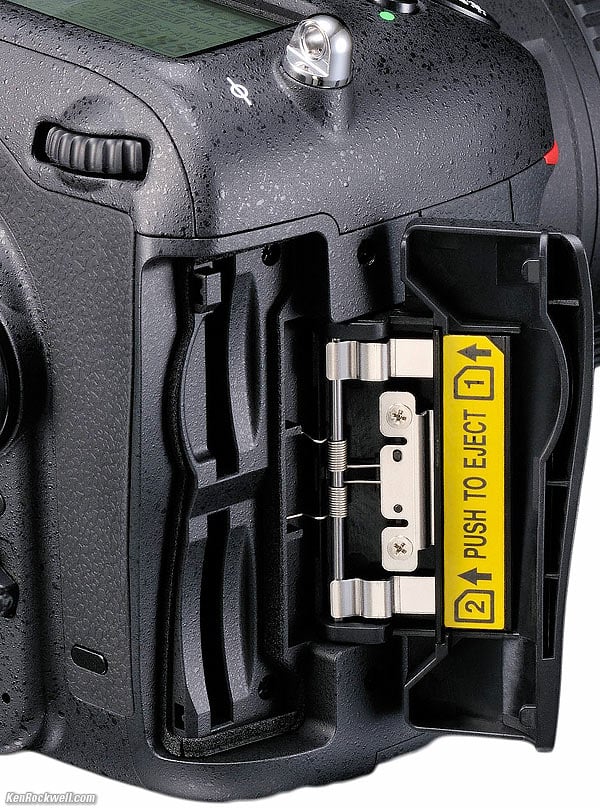
Nikon D7200 dual SD card slots.
Two slots!
SD, SDHC, SDXC and UHS-1 cards, up to at least 64GB, as of late 2010.
Connections top
GPS terminal for GP-1 (use the remote-control connector, below and to the right of the HDMI connector on the side of the camera with all the rubber covers).
USB.
Type-C (full-sized) HDMI.
3.5mm mic in with power.
3.5mm audio out.
Wi-Fi top
IEEE 802.11b, IEEE 802.11g.
Operating frequency 2412 to 2462 MHz (channels 1 to 11).
Claimed range (line of sight) Approx. 30 m/98 ft (assumes no interference; range may vary with signal strength and presence or absence of obstacles).
Data rate not more than 54 Mbps.
Authentication: Open system; WPA2-PS.
Wireless setup: Supports WPS.
Access protocols" Infrastructure
NFC top
NFC Forum Type 3 Tag.
Power top
EN-EL15 battery, first seen with the D7000, and now also used in all larger Nikons like the D810, D800, D800E, D750, D610 and D600, D7100 and other midsized Nikon DSLRs.
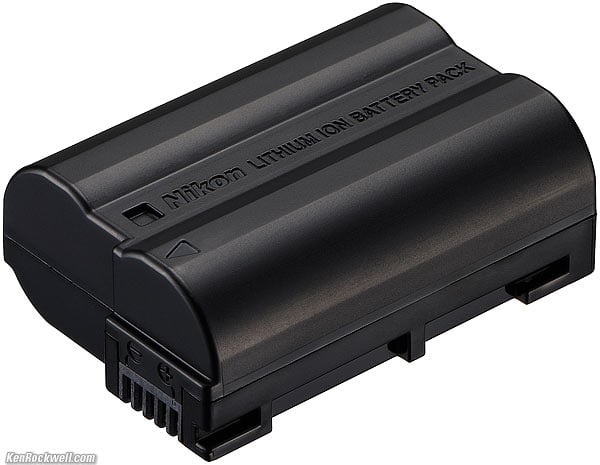
Nikon EN-EL-15 Li-Ion Battery.
Uses Nikon's usual dorky MH-25a charger.
The MH-25a charger is as idiotic as earlier Nikon chargers. Instead of a flipping plug like a good charger, it has a screwy flipping socket into which you either plug the bizarre short US plug, or a standard charger cord.
The charger is clumsy, requires you slip the battery into the hole instead of popping it in from the top like most good chargers, is useless unless you also bring another cord and plug, and the light is Nikon's standard blink while charging and solid when done. There is no indication of charge percentage while charging. This charger is one of the things I like least about the D7200. If this is my biggest complaint, this is a very good camera!
Nikon MH-25a charger, included with Nikon D7200. enlarge.
Rear, Nikon MH-25a charger. enlarge.
In the USA, the charger comes with both a cord and a more portable semi-folding stub.
Optional MB-15 grip takes the EN-EL15 battery, or 6 AA cells.
Optional AC adapter EH-5a and EP-5 power connector.
Exoskeleton top
Most of the D7200's body is magnesium alloy.

Nikon D7200 and MB-15 Grip Magnesium Cores.
Size top
5.4 x 4.2 x 3.0 inches. (D7100 is 5.3 × 4.2 × 3.0 inches; D7000 is 5.2 × 4.1 × 3.0 inches.)
135.5 x 106.5 x 76 millimeters. (D7100 is 135.5 × 106.5 × 76 millimeters; D7000 is 132 × 105 × 77 millimeters.)
Weight top
Nikon specifies 27.0 oz. (765 g) with battery and card, but no caps or straps.
Nikon specifies 23.9 oz. (675 g), stripped naked. (D7000 is 24.3 oz. (690 g), stripped naked.)
Environment top
0 ~ 40ºC (32 ~ 104ºF).
Less than 85% RH, non-condensing.
Quality top
Bottom, Nikon D7200. enlarge.
Made in Thailand.
What's Included
Box, Nikon D7200. bigger.
D7200 Camera Body
(18-140mm VR lens if included)
EN-EL15 Rechargeable Li-ion Battery
MH-25a Quick Charger and power plug stub (no cord)
UC-E17 USB Cable (the D7000 takes the UC-E4)
AN-DC1 Strap
DK-5 Eyepiece Cap
DK-23 Rubber Eyecup (the D7000 takes the DK-21)
BF-1B Body Cap
Separate English and Spanish printed manuals
The D7000 also includes all these same items, and also an analog audio video Cable EG-D2 and LCD Cover BM-11, neither of which ship with the D7100 or D7200.
TheD7000 and D7100 included a BS-1 hot-shoe cover, which the D7200 does not.
TheD7000 and D7100 included a Nikon View software 2 disc, which the D7200 does not.
Announced top
01 March 2015, 9PM NYC time.
Promised for top
April 2015.
Shipping Since top
26 March 2015, a little ahead of schedule.
Price top
April 2017: $997 body only, or $1,297 with 18-140mm.
November 2015: $1,097 body only, or $1,397 with 18-140mm.
March-July 2015: body-only for $1,199, or with 18-140mm for $1,497.
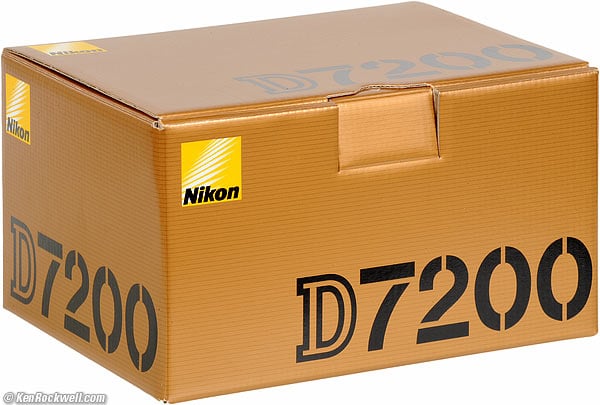
Box, Nikon D7200.
Accessories top
Sample Images Intro Specifications Accessories USA Version
Performance Compared Usage Recommendations More
ME-W1 Wireless Microphone ($250)
The D7200 takes the same grip as the D7100.
Nikon D7100 with MB-D15 grip. bigger.
The Nikon MB-D15 grip (Nikon part number 27096) has a shutter-release button, AAE/AF lock button, multi thumb selector, and both front and rear command dials for vertical shots.
Also called the "MB-D15 Multi-Power Battery Pack," the MB-D15 can be powered by six AA cells (Alkaline or Ni-MH or Lithium) or the camera's own EN-EL 15 rechargeable Li-ion batteries.
To use with AA cells, use the included MS-D14 AA Battery Holder. (I suspect a typo here and that this may really be the MS-D15 AA.)
To use the EN-EL15 batteries, use the included MS-D14EN Battery Holder. (I suspect a typo here and that this may really be the MS-D15EN.)
If you use an EN-EL-15 in the camera and a second one in the grip, Nikon rates them for a total of 1,900 continuous shots.
GPS Unit GPS-1A ($250)
This plugs into the remote control connector.
Remotes top
ML-L3 Wireless Remote ($18)
Nikon ML-L3 Remote.
The Nikon D7200 uses this tiny $18 infrared remote. It's the best $18 you'll spend with Nikon, because it also works with most of Nikon's other less expensive DSLRs. (Nikon's expensive SLRs only work with the dorky cords, sorry; only the inexpensive ones work with this great wireless remote.)
For instance, the D300s requires you buy a $150 receiver system in order to work with a wireless remote. Otherwise, you have to use an expensive cord.
Wireless remote controller WR-R10 ($100).
Remote cord MC-DC2 ($25).
See also wireless options.
Wireless Control WR-1
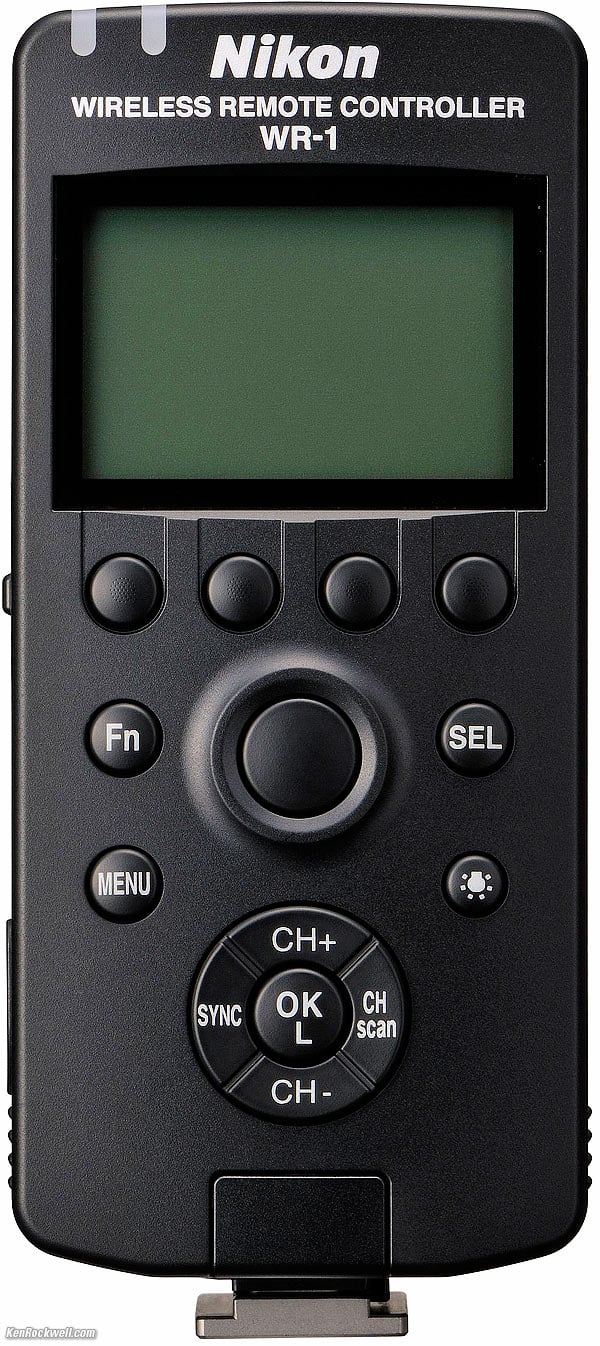
Nikon WR-1 radio remote.
The WR-1 allows radio remote control out to about 100 meters (300 feet) under unusually good conditions outdoors, and much less indoors. Buy a few of these, and you can control quite a few cameras at the same time. I believe you can fire them all at once, or in sequence.
That's the good news. The bad news is that this radio release isn't really wireless; you have to wire it to the D7200:
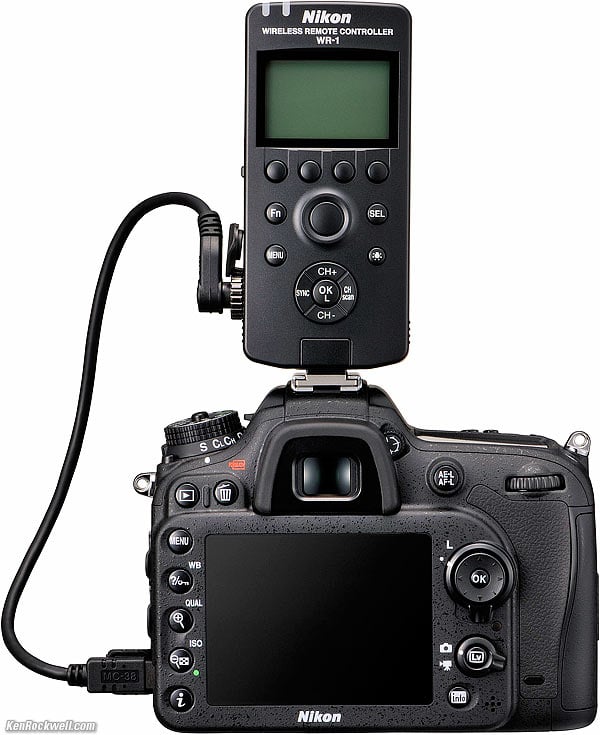
How you connect the WR-1 to the D7200.
You need to buy more than just one to use at your D7200; you still need a second WR-1 in your hand remotely as well as the one on the D7200!
When you do this, you can set and see most of the D7200's settings on the WR-1 in your hand.
Getting a Legal USA Version (for USA only)
Sample Images Intro Specifications Accessories USA Version
Performance Compared Usage Recommendations More
USA Nikon D7200 box end. bigger.
In the USA, be sure your box has "US" after "D7200" and the color code ("BK" on this black one) above the UPC bar code on the lower left.
If the letters are different, you got ripped off with a gray market version from another country. This is why I never buy anyplace other than from my personally approved sources. You just can't take the chance of buying elsewhere, especially at retail, because non-USA versions have no warranty in the USA, and you won't even be able to get new firmware or service for it — even if you're willing to pay out-of-pocket for it when you need it!
Always be sure to check your box while you can still return it, or just don't buy from unapproved sources, so you'll be able to have your camera serviced and get free updated firmware as needed.
Most importantly, the legal USA version has a gray warranty card from Nikon USA with the same serial number as your box and your camera, and there is a white "U - S" sticker on the plastic bag holding the manuals:
USA Nikon D7200 box contents. bigger.
The important part is the Nikon USA warranty paper, whose serial number must match the one on your camera. If you have that, don't get too bent out of shape if the sticker on the manuals says U-K or the box is a little different. If you've got a Nikon USA warranty card with a matching serial number, you're OK.
Performance top
Sample Images Intro Specifications Accessories USA Version
Performance Compared Usage Recommendations More
Autofocus performance top
The D7200 has Facial Recognition, but only on playback or in Live View. To turn it on in Live View, hold the AF mode button near the bottom of the lens on the front and spin a dial until you see AF-F on the rear LCD.
Autofocus has no Facial Recognition for normal viewfinder shooting. The AF system in its Auto Area AF mode will simply focus on whatever's closest.
If you need real facial recognition, get the D750, which is superb, The D750 easily sees past distractions and identifies and focusses automatically on faces by magic, while the D7200 just locks onto whatever's closest in Auto-Area AF mode.
Ergonomics performance top
An improvement is that basic settings like WB, QUAL and ISO now also turn on the rear LCD as you set them. You used to have to squint at the top LCD instead.
QUAL doesn't show pixel counts on the rear screen, just size, format and quality and the shots left.
There is no longer a way to change settings on the INFO screen as we could in the D7100. The INFO screen shows information, but we can't press INFO again to change it from there as we can with Canon. (to change things on the INFO screen, press the 'i' button to see a short menu of some of the items on the INFO screen.)
Thankfully the INFO screen stays on as you swap exposure modes so you can look at it as you set exposure modes (better than Canon who turns off the screen as you turn their mode dial), but the U1 or U2 graphic is still almost invisible.
There's no option to allow the U1 and U2 modes to auto-update themselves as you change settings.
The power switch is still defective in design like most Nikons, and often gets knocked to ON or OFF accidentally. As a cost-saving measure, Nikon removed the lock, as the F5 had on this switch. Nikon needs to redesign this switch, as Canon did years ago.
In spite of all my whining, the D7200 is marvelous because I can program the U1 and U2 modes for completely different scenarios. I set U1 and U2 as explained under Usage.
Viewfinder performance top
The finder is bright, sharp and clear. No news here.
The data along the bottom of the screen is white.
The flash-ready bolt is orange.
AF areas are opaque black LCD boxes that can obstruct the subject. They are edge-lit in red at night.
Meter and Exposure performance top
Nikon keeps getting better, and the meter in my D7200 seems pretty much infallible. I get great exposure under any crazy lighting condition without needing exposure compensation.
Built-in Flash performance top
The built-in flash is swell.
Exposure is right-on, a Nikon hallmark, and it usually recycles almost instantly. One catch is that even if it would fire, the CL and CH modes revert to S (single frame) with the flash on; use S mode and keep pressing quickly.
Katie and a new Happy Meal toy, 08 April 2015. D7200, built-in flash ON, 35/1.8 DX, f/6.3 at 1/250 at ISO 100, Perfectly Clear V2. bigger.
See? We were sitting in the shade, and the built-in flash lit Katie perfectly, all automatically.
High ISOs performance top
High ISO performance is spectacular, but we expect that today.
Can you remember 2006, back when we avoided ISOs like 3,200 because they looked ratty, noisy, blotchy and off-color, even at small sizes? As I show below, D7200 images shot at ISO 25,600 look the same at normal sizes as those shot at ISO 100, a huge testament to the incredible performance we take for granted today.
Only at ISO 25,600 do the shadows become a little rougher, but so what? If you need ISO 25,600 for a sharp photo, use it. Otherwise, the shadows and highlights and colors and everything look the same. A few years ago ISO 25,600 would have had blotchy faded colors and lifeless black shadows, while the D7200 looks great at ISO 25,600 if you need it.
To see the tiny differences between these today, download the camera-original files and compare them at home. You'll see a less fine detail in higher ISO shots, as well as less texture. Look for the details in the wood grain both on the wall and on the base of the clock: the wood grain is smoothed-over by the noise reduction at the higher ISOs — but you'll never see this at normal print sizes or online.
These minor differences don't matter: a sharp, in-focus and unblurred photo at ISO 25,600 with the D7200 is always going to be sharper than one with less depth of field or blurred from a using a slower ISO if things are moving or if it's night and you have no tripod. If you need ISO 25,600, use it.
Don't compare colors, exposure or sharpness to other cameras on which I've shot the same thing; this fine home is always in different light when I shoot these and I probably have the cameras set differently. Use these samples to see just how little changes as you turn up the ISO; all that really changes is that the finer textures go away.
Complete Images
Click any for its 5 MB camera-original LARGE BASIC JPG file.
Click any for its 5 MB camera-original LARGE BASIC JPG file.
Crops from the above images at 100%
These are crops at 100% pixel-to-pixel from the above, the equivalent of extremely large prints.
If these below are about 6" (15 cm) on your screen, then the entire image printed at this same magnification would be huge 40 x 60" (1 x 1.5 meter) prints!
As you will see, the noise looks about the same up to about ISO 12,800.
What changes more than the noise is that all the fine textures go away as the ISO increases. While sharp edges (the numbers on the clock) stay sharp, subtle textures in the wood grain completely disappear as the ISO increases! Look for the detail in the black base; only at lower ISOs will you see artwork there! This is because today's noise reduction works by smoothing-over the fine details, which smooths both the noise as well as the image. At the highest ISOs, it's as if the image got wet and smeared!
There isn't any significant noise until ISO 25,600, while finer details start going away at much lower ISOs. Subtle textures go away at middle ISOs, and at the highest ISOs, look how the fine circles around the edge of the clock face simply disappear!
This is how all noise reduction works. It tries to throw away noise, and at the highest ISOs it throws away some picture, too.
The full images above look swell, even at ISO 25,600. What this shows us below is that the degradation at higher ISOs only matters if you're making huge prints — and then standing this close to them.
Crops from the above images at 100%
Click any for its 5 MB camera-original LARGE BASIC JPG file.
Click any for its 5 MB camera-original LARGE BASIC JPG file.
Sharpness performance top
Yes, it's sharper than anyone will ever need for anything.
In this case, every thread of this tapestry is obvious in this hand-held shot made in the shade:
Jazz. D7200, 35/1.8 DX, f/3.5 at 1/60 at ISO 100. © camera-original JPG.
See every vein in every leaf, every line of texture in the stucco and every chip in the paint of the railing:
Wells Fargo, 08 April 2015. D7200, 35/1.8 DX, f/7.1 at 1/200 at ISO 100. © camera-original JPG.
See every frond, no color smearing and no blurring from anti-alias filters:
Palm, 09 April 2015. D7200, 35/1.8 DX, f/10 at 1/400 at ISO 100, Perfectly Clear V2. © camera-original JPG.
Color performance top
Color. Nikon D7200,Nikon 35-105 AF-D at 75mm, f/6.3 at 1/640 at Auto ISO 100, Perfectly Clear V2. © camera-original JPG.
Color rendition is the same as my other Nikons, which is superb.
It seems that any Picture Control setting matches my other Nikons, so since I know how to get the colors I want from my other cameras, I already know how to do it from the D7200.
This is why Nikon and Canon dominate the pro market: because the pictures look better because the cameras interpret colors better than cameras from lesser makes like Sony, LEICA, Fuji, Casio and the lower tiers.
Quiet Mode performance top
As on all Nikon DX cameras, the Quiet Mode isn't.
We set it with the Q on the top left advance mode dial, but all it does is break up the shutter release and shutter charge operations into separate operations.
In Quiet Mode, the D7200 makes two slightly quieter clicks when you press the shutter button, and then a third click when you release the button.
It's not quieter than the usual mode, but it's much slower — and there are no continuous modes when you've selected Quiet.
For a good Quiet Mode, try the D810, whose Quiet Mode really works, and works fast in Continuous mode, too.
Playback performance top
Playback is the usual.
The LCD looks great.
Oddly sometimes it can take a moment for playback to happen, as if I have a card full of a hundred directories in my other Nikons, but this will happen even with a nearly blank, freshly formatted card.
The controller works in all eight directions.
The dials can be set in the menus to work during playback.
Face recognition works great on playback for zooming right into various faces.
Data performance top
Images are tagged as 300 DPI.
Cards are properly formatted, labeled "NIKON D7200."
The HDMI jack is full-sized, just like on your DVD player, so it's easy to plug it in when you go visiting. No longer does it use an oddball miniature connector.
Compared top
Sample Images Intro Specifications Accessories USA Version
Performance Compared Usage Recommendations More
The D7200 and previous D7100 and D7000 are pretty much the same. They all have U1 and U2 Instant Recall Modes, two SD card slots and 2,016-segment RGB light meters. If you own a D7100 or D7000, there's no reason to update unless there's something particular about the D7200 that you really need.
The D7200 is better than the D5500 and D3300 because it has more buttons and dials to let you set the camera more quickly — but these only matter if you actually change these settings. The D5500 and D3300 require most settings to be made inside menus. The D5500 has a touch screen, unlike any other Nikon DSLR, which helps it set about as fast as the D7200. The D7200 is significantly heavier and more expensive than the D5500 or D3300, while the sensor and picture quality are exactly the same.
The Full-Frame D750 is better than the D7200 mostly because it has face recognition while shooting. If you photograph people, this is a huge help because it can automatically find and focus on people in your frame as you shoot normally through the viewfinder, which greatly speeds up your shooting. Otherwise, the only real reason today to get a full-frame camera is if you're like me and enjoy using your ancient full-frame lenses to their fullest, if you want a larger viewfinder, or want narrower depth of field, Otherwise, the images from the D750 are the same, and in fact the two cameras handle so similarly that I usually have to look at the label on the bottom to see which is which!
See other comparison tables at D7500 Comparisons.
| Announced | 4/2017 |
3/2015 |
2/2013 |
9/2010 |
1/2015 |
1/2014 |
7/2009 |
8/2008 |
| Resolution | 21MP |
24MP |
24MP |
16MP |
24MP |
24MP |
12MP |
12MP |
| Card Slots | 1 SD |
TWO SD |
TWO SD |
TWO SD |
1 SD |
1 SD |
1 CF 1 SD |
1 SD |
| U1 U2 Instant-Recall? | Yes |
Yes |
Yes |
Yes |
no |
no |
no |
no |
| ADR? | Yes |
Yes |
Yes |
Yes |
Yes |
Yes |
Yes |
Yes |
| Image | ||||||||
| Frame Rate* | 8 FPS |
6 FPS |
6 FPS |
6 FPS |
5 FPS |
5 FPS |
7 FPS |
4.5 FPS |
| AF with AF lenses? | Yes |
Yes |
Yes |
Yes |
no, needs AF-S |
no, needs AF-S |
Yes |
Yes |
| AF Points** | 51 |
51 |
51 |
39 |
39 |
11 |
51 |
11 |
| AF-mode selections | Button and dials |
Button and dials |
Button and dials |
Button and dials |
Menus |
Menus |
Levers |
Menus |
| Finder (@ 28mm) | 0.53x |
0.53x |
0.53x |
0.53x |
0.46x |
0.48x |
0.53x |
0.53x |
| Built-in mic | Stereo |
Stereo |
Stereo |
mono |
Stereo |
mono |
mono |
mono |
| Flash Sync | 1/250 |
1/250 |
1/250 |
1/250 |
1/200 |
1/200 |
1/250 |
1/200 |
| LCD | 3.2" 922k |
3.2" 1,229k |
3.2" 1,229k |
3" 922k |
3.2" 1,037k flips |
3" 920k |
3" 920k |
3" 920k |
| Remote | 10-pin |
|||||||
| Battery | EN-EL15a |
EN-EL15 |
EN-EL15 |
EN-EL15 |
EN-EL3e |
EN-EL3e |
||
| Weight, wet*** | 720g |
765g |
774g |
774g |
466g |
455g |
932g |
710g |
* D7200 can run 7 FPS in its oddball 1.3x crop mode, and D300s can run 8 FPS with more batteries in bigger, optional grip. I don't care, but have been told that the D300s can only shoot at 2.5 fps at 14-bit RAW, while the D7200 can still shoot 6 fps at 14-bit RAW.
** 39 is the same as 51; they all are fields of AF points. 39 to 51 is the same as 40 to 50, which looks the same.
*** As actually measured by me, with battery and card.
Usage top
Sample Images Intro Specifications Accessories USA Version
Performance Compared Usage Recommendations More
My Setup File
If you just want to set up your D7200 exactly as I have mine set, simply download and copy this NCSETUPF.BIN file to your computer. This file is new as of 8 PM 08 April 2015.
It won't do anything in your browser or on your computer. You have to download it to your computer, copy it to a memory card, pop that card into your D7200, then MENU > SETUP > Save/load settings > Load settings > YES to replace your settings with mine.
Feel free to load them into your D7200, but know that my D7200 is programmed to add my name and contact information to the EXIF data of every photo I snap. This should be an incentive to update your copyright and contact information, otherwise your photos will be marked with my information You will need to update your information in three places: MENU > SETUP > Image Comment and MENU > SETUP > Copyright information for both Artist and Copyright.
I set many things, but the basics are:
U1 (places and things)
AF-A, Auto-AF Area select.
LARGE BASIC optimize quality JPG.
VIVID Picture Control, 8 sharpening, +3 Saturation.
U2 (people)
AF-C, Auto-AF Area select.
SMALL BASIC optimize quality JPG
Portrait Picture Control, 8 sharpening, +1 Saturation.
To set each later, set your camera as you want it, then MENU > SETUP (wrench) > Save user settings > Save to U1 (or U2) > Save settings > OK.
Rapid Flash Shots
The built-in flash cancels the CL and CH modes, reverting to S mode.
To shoot rapidly with the built-in flash, keep pressing the shutter repeatedly. Stay close enough, and you can shot very quickly. (Recycle time increases with the square of the distance.)
Better, use an external flash like SB-400 or SB-500 and the CL and CH modes work as usual.
Autofocus
Hold the button on the shooter's left near the bottom of the lens and spin the two dials to set this.
AF Mode
Hold the AF setting button, and then the rear dial sets this.
The choices are AF-S (single; focus once and lock), AF-C (continuous tracking AF), or my favorite, AF-A, (auto) which selects either of the two other modes depending on if the subject is moving or not.
AF-Area Mode
Hold the AF button and then the front dial sets the AF-Area Mode, meaning which of the many AF areas are used.
I usually use AUTO, which just finds the correct zone or zones automatically.
If AUTO isn't finding the right area(s), I use S (single) to select one zone manually with the rear selector.
If I want to pick the zone and let the camera track the subject all over the frame, select 3D.
Magic Tracking
If you'd like the camera to move the AF area all over the frame tracking your subject, use the front dial to select 3D — or just use AF-C (rear dial) and AUTO.
When you use AF-C and AUTO area select, the camera just magically tracks the subject all around, up and down, left and right and in and out. It won't do this in AF-S (single) mode, but it will do this in AF-A if it decides the subject is moving.
Since I love this mode when snapping people, I usually select AF-C, since if they are holding still, AF-A will lock and not track them if they move.
People, Places and Things
I use AF-A and AUTO Area Select, which usually just locks as soon as focused, but will track if something just happens to be moving.
If AUTO AF Area doesn't find the subject, I use Single AF area and set it myself, with AF-S to be sure it locks.
Sports
For shooting sports and action, I set AF-C and either Auto AF-Area or 3D.
In 3D, you have to select the AF Area manually, and then the selected area will run all over the frame tracking your subject.
Also see How to Shoot Sequences with Flash and How to Shoot Sports.
Recommendations top
Sample Images Intro Specifications Accessories USA Version
Performance Compared Usage Recommendations More
If you think you want one, get one. The D7200 is Nikon's best DX camera.
If you already have a D7000 or D7100, there's no rush to replace them. They're all pretty much the same. Whether or not the difference matters enough to you is revealed at Is It Worth It. If you're shooting a dinosaur like a D80 or D90, then by all means turn your old camera in at your police station and get a D7200 pronto.
Get this D7200 over a D5500 or D3300 if you often change your settings, since the D7200 has more direct-entry buttons that make changing settings faster than using menus in the D5500 or D3300. If you rarely fiddle with the settings, I'd suggest the D5500 because the pictures are the same, the D5500 weighs and costs only 2/3 what the D7200 does — and the D5500's unique touch screen makes it almost as fast to set as the D7200.
I really like the little D5500: it's smaller, lighter, takes the same pictures as the D7200 and is also pretty easy to set. The advantages of the D7200 are the U1 and U2 dial settings if you need to swap between two different kinds of shooting as I do (one for kids and one for landscapes), or if you like to use old manual-focus lenses. The D7200 is perfectly compatible for metering and EXIF data with manual focus lenses from decades ago as shown at the top, while the D5500 and below have no metering with these old lenses.
There's no need for a D610 or full frame camera unless you want a larger viewfinder and/or prefer less depth of field. The pictures otherwise look the same, and unless I look at the label, I can't tell the difference between my D750 and my D7200 — they feel, handle and operate the same.
There is a very good reason to step up to the D750, and that's for photographing people. Unlike these other cameras, the D750 (and D810) have face recognition that works for normal viewfinder shooting, and will automatically locate and focus on faces without you having to select an AF area manually. The D7200, D5500 and D3300 have AUTO AF-Area select modes, but they are not smart enough to locate faces, so instead they focus on whatever's closest — even if it's an interfering element.
I love my D7200, but if I was starting again, I'd just as well get the ultralight D5500 with its handy touch screen, or step right up to the D750 to get facial recognition which is a huge time saver for my people photos.
If you're comparing to Canon, the 7D Mark II is a completely revolutionary camera years ahead of any Nikon DX camera. If you aren't already invested in the Nikon system, I greatly prefer the 7D Mk II, which is almost twice as fast for sports and way smarter than the D7200 could ever be. It costs 40% more, but it's twice as good.
Where to get it
I got mine at Adorama, who has the body for $1,097, and the kit with 18-140 for $1,397. B&H also has the body and the kit with 18-140mm. I'd also get it at Amazon or at Crutchfield.
Be sure to get yours only from an approved source, and never at retail.
Lenses
I wouldn't order it with the 18-140mm VR lens, which is a pretty boring lens for $500 extra, but for $300 after Nikon's $200 deal, it's a swell lens. Honestly, if I want a zoom to carry around, I prefer the much smaller, lighter and less expensive featherweight 18-55mm VR II.
I ordered the body-only, and prefer my excellent 35mm f/1.8. That's what I shoot on my DX cameras most of the time. The 35/1.8 is superb for just about everything, especially for action in low light. For under $200, you've got to get one.
If you insist, the 18-200mm VR II (or 18-300mm VR DX or 18-300mm VR DX II) is all you need for everything, except for action in low light, but either is very big and heavy.
If I need wider angles, I use my 10-24mm, but be sure you know How to Use Ultrawide Lenses.
Another suggestion is to get the 10-24mm and the 35mm f/1.8, and then your choice of smaller dedicated telephoto zoom. Either of the 55-200mm VR or 55-300mm VR are excellent, but for action, the 70-300mm VR has much faster autofocus. Most professionals use the huge 70-200mm VR II all day for everything.
Se also the DX Dream Team and Assembling a System.
I rarely shoot my D7200 with anything other than my 35/1.8 DX. I might bring my 55-200 VR if I'm expecting something far away, and otherwise I like to carry as little as possible.
Flash
Before you go buying another flash, try the built-in first. It's probably all you need unless you're shooting professional sports or portraits outdoors all day at rapid speeds or long distances. This isn't 1975; the built-in flash works great today.
If I need more range or fast recycling for heavy outdoor fill-flash shooting, I use my tiny and excellent SB-400 flash.
The SB-500 is also superb and even more powerful, but bigger.
More Information top
Sample Images Intro Specifications Accessories USA Version
Performance Compared Usage Recommendations More
© Ken Rockwell. All rights reserved. Tous droits réservés. Alle Rechte vorbehalten.
Help me help you
I support my growing family through this website, as crazy as it might seem.
The biggest help is when you use any of these links when you get anything, regardless of the country in which you live. It costs you nothing, and is this site's, and thus my family's, biggest source of support. These places have the best prices and service, which is why I've used them since before this website existed. I recommend them all personally.
If you find this page as helpful as a book you might have had to buy or a workshop you may have had to take, feel free to help me continue helping everyone.
If you've gotten your gear through one of my links or helped otherwise, you're family. It's great people like you who allow me to keep adding to this site full-time. Thanks!
If you haven't helped yet, please do, and consider helping me with a gift of $5.00.
As this page is copyrighted and formally registered, it is unlawful to make copies, especially in the form of printouts for personal use. If you wish to make a printout for personal use, you are granted one-time permission only if you PayPal me $5.00 per printout or part thereof. Thank you!
Thanks for reading!
Mr. & Mrs. Ken Rockwell, Ryan and Katie.
Home Donate New Search Gallery Reviews How-To Books Links Workshops About Contact

